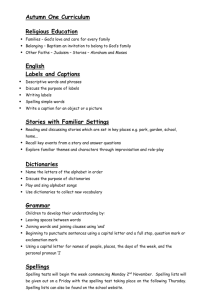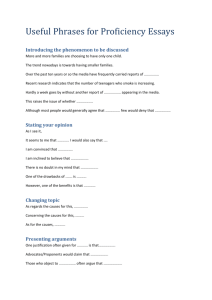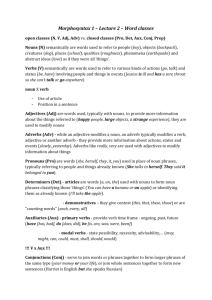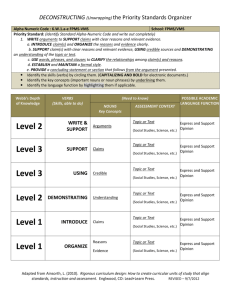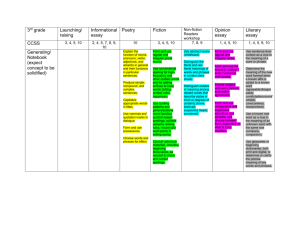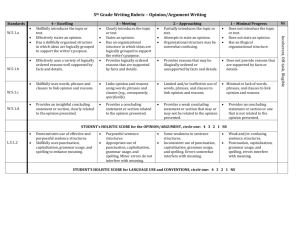Unpacked ELA L Standards
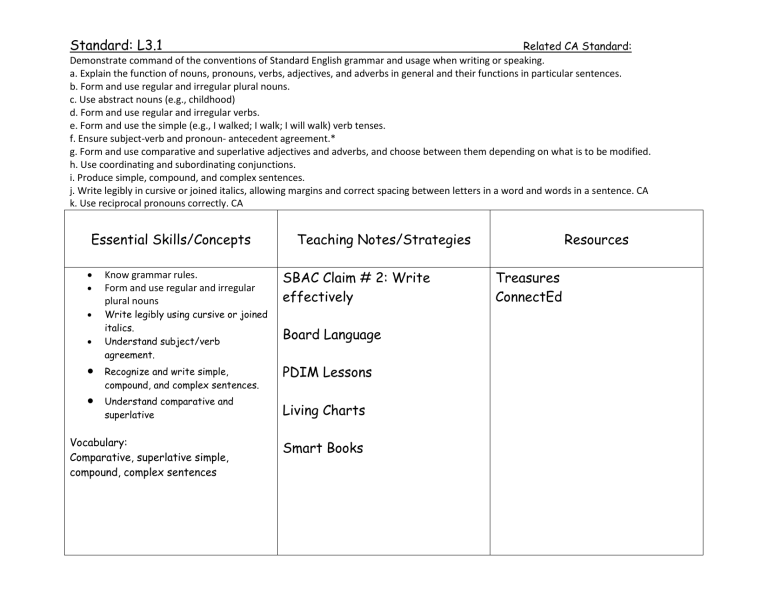
Standard: L3.1 Related CA Standard:
Demonstrate command of the conventions of Standard English grammar and usage when writing or speaking. a. Explain the function of nouns, pronouns, verbs, adjectives, and adverbs in general and their functions in particular sentences. b. Form and use regular and irregular plural nouns. c. Use abstract nouns (e.g., childhood) d. Form and use regular and irregular verbs. e. Form and use the simple (e.g., I walked; I walk; I will walk) verb tenses. f. Ensure subject-verb and pronoun- antecedent agreement.* g. Form and use comparative and superlative adjectives and adverbs, and choose between them depending on what is to be modified. h. Use coordinating and subordinating conjunctions. i. Produce simple, compound, and complex sentences. j. Write legibly in cursive or joined italics, allowing margins and correct spacing between letters in a word and words in a sentence. CA k. Use reciprocal pronouns correctly. CA
Essential Skills/Concepts
Know grammar rules.
Form and use regular and irregular plural nouns
Write legibly using cursive or joined italics.
Understand subject/verb agreement.
Recognize and write simple, compound, and complex sentences.
Understand comparative and superlative
Vocabulary:
Comparative, superlative simple, compound, complex sentences
Teaching Notes/Strategies
SBAC Claim # 2: Write effectively
Board Language
PDIM Lessons
Living Charts
Smart Books
Treasures
ConnectEd
Resources
Standard: L3.2 Related CA Standard
Demonstrate command of the conventions of Standard English capitalization, punctuation, and spelling when writing.
a. Capitalize appropriate words in titles. b. Use commas in addresses. c. Use commas and quotation marks in dialogue. d. Form and use possessives. e. Use conventional spelling for high-frequency and other studied words and for adding suffixes to base words (e.g., sitting, smiled, cries,
happiness). f. Use spelling patterns and generalizations (e.g., word families, position-based spellings, syllable patterns, ending rules, meaningful word parts) in writing words. g. Consult reference materials, including beginning dictionaries, as needed to check and correct spellings.
Essential Skills/Concepts Teaching Notes/Strategies
Use quotation marks to show someone is speaking.
Understand the use of commas in dialogue and addresses.
Possessives
Capitalization rules
Apply knowledge of spelling patterns
Use dictionaries to look up correct spelling of a word
Vocabulary:
Dialogue,
SBAC Claim # 2: Write effectively
Daily Language Practice editing
Resources
Dictionaries
Standard: L3.3 Related CA Standard
Use knowledge of language and its conventions when writing, speaking, reading, or listening. a .Choose words and phrases for effect.
b. Recognize and observe differences between the conventions of spoken and written standard English.
Essential Skills/Concepts
Basic punctuation, capitalization, and grammar rules.
Recognize words have differences or shades of meaning.
Use punctuation (commas, exclamation, and question marks for effect.
Distinguish between formal and informal English
Vocabulary: shades of meaning, word choice, formal English, Informal English
Teaching Notes/Strategies
SBAC Claim # 5: Use oral and written language skillfully
Resources
Standard: L3.4 Related CA Standard
L.3.4 Determine or clarify the meaning of unknown and multiple-meaning word and phrases based on grade 3 reading and content, choosing flexibly from a range of strategies. a. Use sentence-level context as a clue to the meaning of a word or phrase. b. Determine the meaning of the new word formed when a known affix is added to a known word (e.g., agreeable/disagreeable, comfortable/uncomfortable, care/careless, heat/preheat ). c. Use a known root word as a clue to the meaning of an unknown word with the same root (e.g., company, companion ). d. Use glossaries or beginning dictionaries, both print and digital, to determine or clarify the precise meaning of key words and phrases.
Essential Skills/Concepts
Context Clues
Monitor and Clarify
Meaning of affixes and roots
Use glossaries and dictionaries to determine meaning
Multiple Meaning Words
Vocabulary: multiple meaning, root, prefix, suffix, glossary
Teaching Notes/Strategies
SBAC Claim # 5: Use oral and written language skillfully
Resources
Standard: L3.5
Related CA Standard
Demonstrate understanding of word relationships and nuances in word meanings. a. Distinguish the literal and non-literal meanings of words and phrases in context (e.g., take steps). b. Identify real-life connections between words and their use (e.g., describe people who are friendly or helpful). c.
Distinguish shades of meaning among related words that describe states of mind or degrees of certainty (e.g., knew, believed, suspected, heard, wondered).
Resources Essential Skills/Concepts
Understand that words have literal and non-literal meanings.
Understand the connection between words.
Understand shades of meanings as it relates to state of mind or degrees of certainty.
Vocabulary: shades of meaning, literal meaning, non-literal meaning, real life connections, context
Teaching Notes/Strategies
SBAC Claim # 5: Use oral and written language skillfully
Standard: L3.6
Related CA Standard
Acquire and use accurately grade-appropriate conversational, general academic, and domain-specific words and phrases, including those that signal spatial and temporal relationships (e.g., After dinner that night we went looking for them).
Essential Skills/Concepts
Appropriate word choice
Understand domain specific words and phrases
Develop and use grade level academic words and phrases
Vocabulary:
Teaching Notes/Strategies Resources



